Dell 2407WFP and 3007WFP LCD Comparison
by Jarred Walton on March 2, 2007 11:30 AM EST- Posted in
- Displays
Brightness and Contrast Comparisons
For testing, we used a Monaco Optix XR (DTP-94) colorimeter on the hardware side. For software, we used Monaco Optix XR Pro. The software and hardware are relatively easy to use and together they help users fine tune their displays. Before we get to the calibrated results, we took a quick look at how the displays performed at minimum and maximum brightness. Note that we retested all of the displays here for this article, as we adjusted our testing procedures slightly in order to make sure we were providing the most consistent results possible. If you refer back to our previous Gateway FPD2485W article, you'll notice slight differences in the scores we are reporting today.
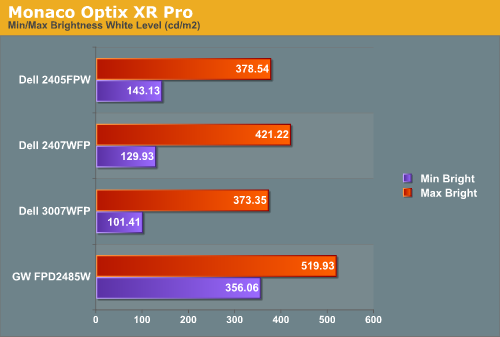
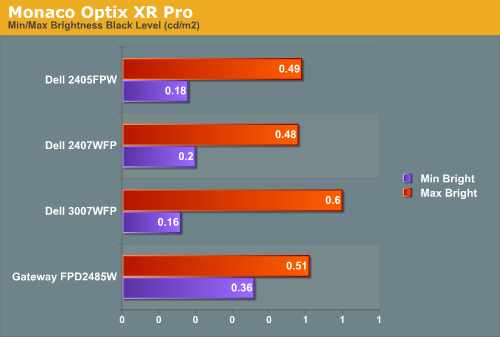
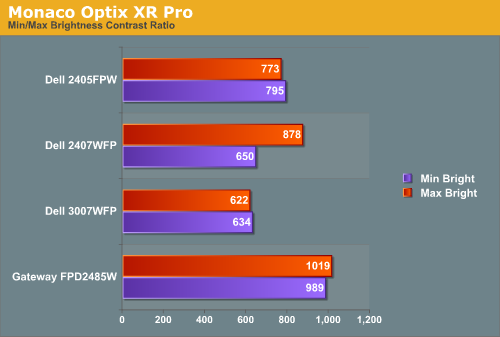
All three of the Dell LCDs are relatively consistent in terms of brightness levels and contrast ratios. The Gateway FPD2485W on the other hand is clearly brighter than the other LCDs, and it also has a higher contrast ratio. As we mentioned in the Gateway review, however, looking at these numbers really doesn't tell you a whole lot about how a display really performs. In the case of the Gateway LCD, even at minimum brightness it can feel overly bright in some environments. Now let's take a look at the brightness levels and contrast ratios once we've calibrated the LCDs.
We did find that the Monaco Optix XR Pro instructions tend to be a bit aggressive in terms of setting the contrast ratio, but both of the Dell LCDs we're looking at today don't provide an option to adjust contrast. For reference, the Gateway LCD was set to a 60% contrast ratio instead of 100% as the reduced contrast level generated slightly better overall results.
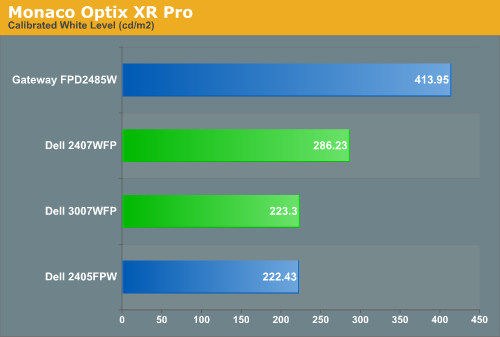
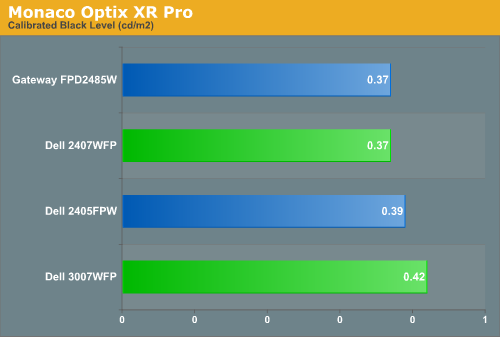
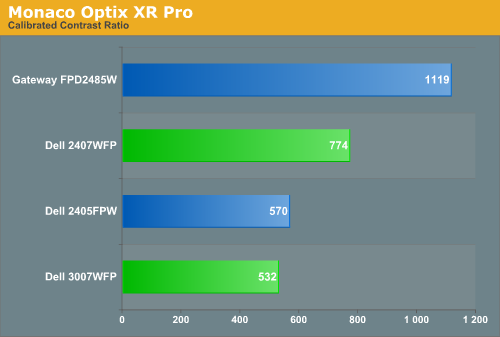
Comparing the calibrated versus min/max brightness, it should be immediately apparent that for most uses you will want to turn down the brightness level. As we'll see on the next page, you can still get good color accuracy even with a bright display, but if you use your computer for long periods at a time a display that's too bright can cause headaches and other annoyances. Theoretically, you want your whites to be brighter and your blacks to be darker, but brighter whites are only good up to a certain point. Anything above 400 cd/m 2 is far too bright in our opinion, and we found all three Dell LCDs tended to feel a bit easier on the eyes. Personal preference will still play a role, however, so if you find that you like really bright displays you might prefer the Gateway LCD.
For testing, we used a Monaco Optix XR (DTP-94) colorimeter on the hardware side. For software, we used Monaco Optix XR Pro. The software and hardware are relatively easy to use and together they help users fine tune their displays. Before we get to the calibrated results, we took a quick look at how the displays performed at minimum and maximum brightness. Note that we retested all of the displays here for this article, as we adjusted our testing procedures slightly in order to make sure we were providing the most consistent results possible. If you refer back to our previous Gateway FPD2485W article, you'll notice slight differences in the scores we are reporting today.



All three of the Dell LCDs are relatively consistent in terms of brightness levels and contrast ratios. The Gateway FPD2485W on the other hand is clearly brighter than the other LCDs, and it also has a higher contrast ratio. As we mentioned in the Gateway review, however, looking at these numbers really doesn't tell you a whole lot about how a display really performs. In the case of the Gateway LCD, even at minimum brightness it can feel overly bright in some environments. Now let's take a look at the brightness levels and contrast ratios once we've calibrated the LCDs.
We did find that the Monaco Optix XR Pro instructions tend to be a bit aggressive in terms of setting the contrast ratio, but both of the Dell LCDs we're looking at today don't provide an option to adjust contrast. For reference, the Gateway LCD was set to a 60% contrast ratio instead of 100% as the reduced contrast level generated slightly better overall results.



Comparing the calibrated versus min/max brightness, it should be immediately apparent that for most uses you will want to turn down the brightness level. As we'll see on the next page, you can still get good color accuracy even with a bright display, but if you use your computer for long periods at a time a display that's too bright can cause headaches and other annoyances. Theoretically, you want your whites to be brighter and your blacks to be darker, but brighter whites are only good up to a certain point. Anything above 400 cd/m 2 is far too bright in our opinion, and we found all three Dell LCDs tended to feel a bit easier on the eyes. Personal preference will still play a role, however, so if you find that you like really bright displays you might prefer the Gateway LCD.










62 Comments
View All Comments
mongo lloyd - Saturday, March 3, 2007 - link
As for the .303mm pixel pitch, keep in mind that a 19" 4:3 1280x1024 screen that I would wager is the most common LCD in use right now is like .295mm and I never heard anyone complaining about the 19" displays...Well, you've heard one now. Out of ALL LCDs (minus the IBM T221, since that one is... a bit... special), the only panels I could ever begin to consider (and that's ignoring all the other faults with LCDs -- CRTs still beat them, and probably always will, if you ask me (at least as long as they use DVI with crappy refresh)) are the 30" 2560x1600 and 20.1" 1600x1200 monitors. I consider 1600x1200 on a good 19" CRT to be the optimal resolution, and the dot pitch on pretty much all LCDs are pitiful in comparison -- and the dot pitch is even more important on LCDs since the pixels are square and thus very sharp.
Also, you probably meant 5:4, not 4:3.
exdeath - Monday, March 5, 2007 - link
I love my F500R 21" .22mm AGP @ 1600x1200 CRT.But when it dies... there is no getting a replacement.
I have dual 1905FP Dell 19" LCDs at work, 1280x1024 5:4 .295 pitch and its quite sharp. They seem to be the standard by which I judge other LCDs by since that is what I am used to staring at all day. The higher pitch doesn't bother me at all.
In fact, being a graphics programmer and having a close up eye for pixel perfect detail, I tend to prefer images with sharp square pixels.
kmmatney - Saturday, March 3, 2007 - link
They do make laptop screens that are 15.4" and 1920 x 1200 resolution, which is a pretty amazing pixel pitch. So LCD dektop monitors are easily capable of better pixel pitch, there must just not be a market for them yet.Everytime I try 1600 x 1200 on a 19" CRT, it looks like crap, and I;'ve tried quite a few CRTs.
JarredWalton - Saturday, March 3, 2007 - link
Funny thing is, I go the other way. Laptop LCDs tend to have text that gets a bit difficult for me to read now. Oh, I can do it, but even 17" 1920x1200 displays are a bit tiny text/icons. I don't think I'd like a 15.4" 19x12 LCD. To each their own, of course.As for the rest, I fully agree that 1600x1200 on a 19" CRT looks pretty lousy - too small again, and I *love* the perfectly square pixels of LCDs. 20" (viewable) CRTs are required for proper 16x12 resolution, in my opinion. Refresh rates are definitely the one issue I have with LCDs - running CRTs at 100 Hz made it so I wouldn't notice shearing due to vsync, and you can't do that with LCDs. To counter that, though, all the pincushion, stretch, rotate, etc. necessary to get a CRT to properly fill the screen always irritated me. Heck, I'd even take an analog connection LCD over CRTs!
exdeath - Friday, March 2, 2007 - link
"Its a 27" compromise between the wider range of capabilities of the 30" and the smaller size of the 24" "Oops that should have been "limited range of capabilities of the 30"
JarredWalton - Friday, March 2, 2007 - link
I haven't used a 2707WFP yet, but I will see if I can get one sent for review.Take care,
Jarred Walton
Editor
AnandTech.com
lash - Friday, March 2, 2007 - link
First of all, thank you for the review. Does anyone know if this monitor suffer from input lag, like most of the 24" models ? Would it be hard to include a input lag test of the monitors reviewed ? Personally I think of it as a big problem when playing fps or online.Resh - Friday, March 2, 2007 - link
Thanks for the review, particularly the section on colour accuracy where you use objective measurement in the form of a colorimeter. Thanks!However, I note that I can't find the calibration targets you used. For example, when I calibrate my display, I'm targetting about 80 - 120 cd/m2 (depends on display type; brighter for LCD) for brightness, gamma 2.2, and a colour temp of 6500K or D65. This is important as it affects, particularly on LCDs, the display's ability to render colour accurately. For example, my Dell 2407FPW can perform with the level of accuracy that the review describes, but only when its brightness is allow to rise close to 300 cd/m2. While this is great for colour accuracy, it isn't very good for screen to print matching as the screen is far too bright for the print to match. Also, that kind of brightness is retina-searing!
In my case, my HP CRT is capable of astonishing accuracy at 80 cd/m2 -- the brightest it can go. If I screen match and make the drop the 2407FPW to that level, suddenly it isn't so accurate -- acceptable, but no match for the HP.
So it would be great if you could calibrate and profile to targets that are relevant for photographers and also make your targets known. Failing that, at least let us know what your targets were and how the eventual profile compared. For example, I asked ColorEyes Display to target 80 cd/m2 on my 2407FPW and the eventual result was 74 cd/m2.
Thanks!
JarredWalton - Friday, March 2, 2007 - link
I used the default (6500K 2.2 gamma), but I'll have to check on the white point value. Obviously, post-calibration it was still very bright (see page 6), so I may need to run calibrations for a lower white point. The Dell's can manage that, but the Gateway is sort of up a creek, since it couldn't get lower than 356 cd/m2 by adjusting the brightness. With contrast set lower, it might be able to get below 200 cd/m2, but probably not while providing any reasonable amount of accuracy. Sorry to say that I don't do anything with print, so that aspect of testing just didn't occur to me.strikeback03 - Monday, March 5, 2007 - link
I bought the Gateway over the weekend. It can go much lower than 356 cd/m^2 if you go to User color and lower the color channels all by the same amount. They ship set to 100, I lowered them all to 60 or so, which allowed me to set brightness to 120cd/m^2.I have some interesting calibration results, I'll post them in the Gateway comments when I get home from work.